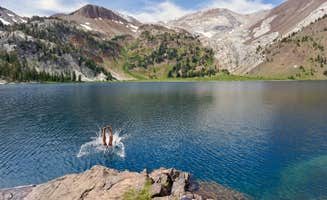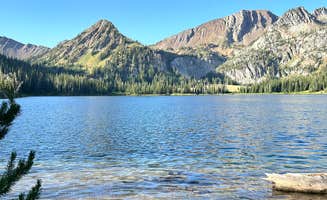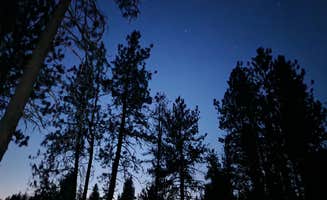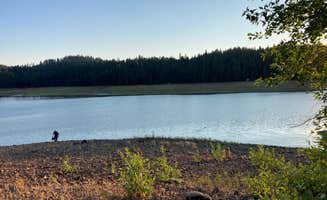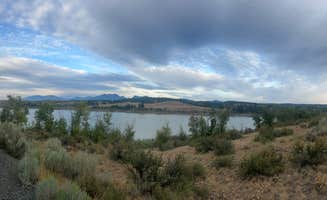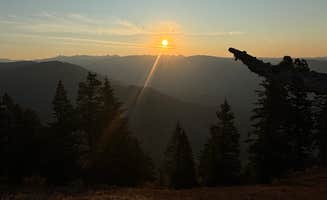Rustic camping near Wallowa, Oregon offers solitude in an area where elevation ranges dramatically from 4,500 feet at river valleys to over 8,000 feet at alpine lakes. Dispersed camping options throughout Wallowa-Whitman National Forest frequently experience seasonal road closures, with most high-elevation sites inaccessible until late June. Summer temperatures typically reach 80-90°F during daytime hours while dropping to 40-50°F at night, particularly at higher elevations.
What to do
Fishing in alpine lakes: Ice Lake provides excellent fishing opportunities for rainbow and brook trout. As one camper noted, "The lake is stocked every few years with rainbow trout, and has a good supply of brook trout."
Wildlife photography: Meadow areas near North Thomason Meadows attract diverse wildlife. A visitor mentioned, "Birdwatching was good for us out here too, especially raptors. One of the trailheads to the historic Nez Perce Nee-Me-Poo Trail is near this 'Camp-1' dispersed spot."
Mushroom hunting: The forested areas in spring and fall offer prime mushroom gathering opportunities. At McDougall Dispersed Camping, one visitor shared, "Just past the village you get into the woodland where the Morels are plentiful. This is an ideal location to go mushrooming."
High-elevation hiking: Many campsites serve as base camps for challenging day hikes. One visitor at Ice Lake reported, "You can add some miles (and a lot of elevation) if you add a day hike to the Matterhorn. Second tallest to Sacajawea. When I say it takes 3 hours to get up and 30 minutes to get down... I'm not joking."
What campers like
Remote solitude: Many campers appreciate the isolation available in more remote camping areas. One visitor to Ice Lake reported, "No fires allowed. No amenities. Back-country hikers only. No cell service. Perfect getaway."
Night sky viewing: Dark skies away from light pollution provide outstanding stargazing opportunities. A visitor at Starvation Springs NF 46 Site shared, "This is a great spot for me and my 20 foot RV, with fantastic starlink speeds. Mid 80's during the day in late July."
Spring wildflowers: The prairie and meadow areas burst with color during late spring. North Thomason Meadows was praised because "it is grazed less than surrounding areas, and thus has more plant diversity--i.e. great WILDFLOWER BLOOM in the spring. At 5000 feet, June to early July is a peak bloom time."
Canyon views: Higher elevation sites offer panoramic vistas. At North Thomason Meadows, "This is the top of the Imnaha River breaks, and you can see fully down into the BEAUTIFUL canyonlands of the Imnaha and Snake."
What you should know
Highway noise: Some easily accessible sites experience traffic noise. At Wallowa-Whitman NF 21, campers noted, "Interstate traffic dominates the soundscape, but the scenery is expansive" and "Down side is it's a little too noisy for my taste."
Trash management: Pack out all waste as some areas have trash problems. One visitor to McDougall noted, "I was disappointed when I was checking out this area for camping (June 27th) I didn't get any pictures, but there was trash everywhere."
Lake temperatures: Alpine lakes remain very cold even in summer. An Ice Lake visitor warned, "The water is no-joke cold. Fantastic nine-mile hike into the forest. Stayed two nights. Elevation is ~8,000 feet. Got altitude sickness on day two."
Road condition variability: Access roads can change dramatically with weather. At Starvation Springs, a camper described, "Not far up a nicely paved road, and then onto maybe 0.3-0.4 mile bumpy gravel/rock FS road."
Tips for camping with families
Choose lake destinations: Alpine lakes provide natural entertainment for children. A visitor to Aneroid Lake Backcountry Dispersed Campsite shared, "The water is very cold but worth the dip if it's a hot summer day."
Consider noise tolerance: Some sites near recreation areas may be noisy but provide built-in entertainment. At Fox Hill Campground, a camper noted, "Ohv park so lots of riders. I enjoyed the sounds of people enjoying themselves. Others may not."
Watch for wildlife with children: Numerous sites offer wildlife viewing opportunities. At Wallowa-Whitman NF 21, one camper reported, "I saw Lots of elk and turkeys(?) and a rattlesnake."
Check difficulty ratings for hikes: Many popular lakes require challenging hikes. A visitor to Ice Lake warned, "The hike to Ice lake is 9 miles in (18 miles total)" which may be too demanding for younger children.
Tips from RVers
High clearance requirement: Many sites require appropriate vehicles. At North Elgin Dispersed Camp, one RVer advised, "Great free place to camp 4x4 is advised and not really car accessible. Down side no water near by, not even a creek."
Easier access options: Some sites offer less demanding approaches. At Starvation Springs, an RVer mentioned, "It's also great that it isn't 5 miles down some super washboarded gravel road. Nice drive to it."
Level site availability: Finding flat parking can be challenging. A visitor to Wallowa-Whitman NF 21 noted, "Good level ground and easy to get back on the road in the morning."
Seasonal planning: Many RV-accessible sites have limited seasons. At McDougall, an RVer warned, "The road to the site was not plowed. Several feet of snow. Not many alternatives in the area so plan accordingly if you hope to stay here."


